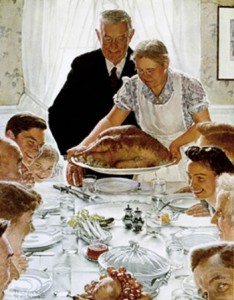
Tag Archives: growth
Thanks to Oprah, gratitude journals were all the rage a while back. And while most wouldn’t peg me as a hipster, thanks-giving has real appeal. That’s because the simple act of gratitude can upshift our immune system. And the on going practice of giving thanks can actually change us at the level of our DNA–maybe more.
Cell biologist, Dr. Bruce Lipton, has a great DVD presentation called, “The Biology of Perception.” In it, he outlines some fascinating fundamentals about how we function at the cellular level, and how that translates to the way we are in the world at large.
In his presentation, Dr. Lipton wonderfully explains the notion that our bodies are always operating in one of two basic modes: growth or protection. Always [and only] one mode or the other. Never both. This paradigm overlays perfectly with the work of Gary Zukav who says we constantly move between two inner states: love or fear. Dr. Lipton describes love to be the number one ingredient for supporting growth in humans. Gratitude is love: love for someone, love for something, love for someplace, love for some belief. All gratitude.
This is where it gets interesting. Our body’s general mode of living or being in the world begins at the level of perception. For example, I love racing motorcycles. Therefore, no matter how many others perceive racing as dangerous, when I race my systems kick into the growth mode since I perceive racing as awesome. When we are in growth mode, our immune systems are bolstered. That’s because when we are in a state of love or gratitude, healthy blood flow is maintained to the gut where the immune system is born. That’s unlike the mode of protection or fear, by which blood is forced out of the gut, to the arms and legs. For me, racing motorcycles establishes a state of love, born of gratitude, which produces growth or health in my body. That’s assuming, of course, I “keep the rubber side down.”
But that’s the thing. What do you think happens to the immune system of someone who cares about me, but perceives racing as dangerous, when she watches me on the track? That person’s body will go into protect mode. In protect mode, the body squeezes blood out of the gut and core organs, and sends that blood to the limbs, readying for fight or flight. Because this fear state robs the belly of blood, the immune system living in the gut of that person watching me race takes a hit. At that point, that spectator is far from a mode of gratitude. And this interrupts growth. All of this gets reflected in the hormonal and nervous systems. And all this has the potential, according to Dr. Lipton and others, to literally redo DNA. (Remember The INNERnet?)
We have the same external event, a motorcycle race, producing a growth response in one person and a protection response in the other. What creates the difference in responses? Not the race. It’s each person’s perception of the race. Think of the implications of perception, beyond a race. How often do we protect simply because of a perception? And what might happen if we had a growth response instead?
Here’s the last and maybe most interesting of Dr. Lipton’s points. This basic love/growth versus fear/protection process begins at the cellular level. He tells us that if you lay a single human cell in a petri dish, and put some form of nutrient near that cell, the cell moves toward the nutrient and grows. But if you put that same human cell in a petri dish and place a toxin near it, the cell moves away to protect itself.
Now multiply that basic process by trillions, the number of cells in each human being. Then multiply that by billions, the number of us on the planet. Dang, that’s a lot of cells and humans either growing or protecting. Nonstop, all of us are either growing or protecting!
So, gratitude and love expand us. Fear and protection contract us. What would happen if all the cells of all the people in the world expanded in gratitude at the same instant? It all starts with perception. Do we look out at the world and see good, or something else?
With that, the prescription for the health of our species comes into focus. When we all find reason for gratitude, the human race grows in love.
Happy thanks-giving.
Some know who God is. Some know who Conservatives are. Some know who Liberals are. Some know Chevy’s are best. Some know organic-only is best. Some know Blacks are best. Some know Whites, or Reds, or Blues are best. Some know who a woman is supposed to be. Some know who a man is supposed to be. Some know football is the true American pastime. Some know yoga is the answer. Some know who lawyers are. Some know the truth. They know there’s a heaven and who gets in, and who goes to hell, because they know there’s a hell. Some know that big government is bad. Some know big business is bad. Some sadly know, “I am bad.” Some know they are right about guns and gays and global warming; wars and walls and WikiLeaks. Some know they tend to think in absolutes. Some don’t.
If we tend to think in black and white, good and bad, all or nothing at all, we learned that thinking style from someone.
If we lived during the era of The Inquisition, and witnessed a woman gathering herbs for healing practices, we would know she was a witch. Black and white. No thinking. It’s what we were taught. “Hmmm. There’s a lady coming out of the woods with a basket full of plants. I’ll tell the authorities.” Done. She’s burned at the stake. No questions. No decisions to be made.
In a way, black and white thinking can be a bit more comfortable as a way to live. More pleasant perhaps because we remain members of the herd. Decisions are made easier when living as part of a culture of absolutes. If we’re not sure, the structure provided by the culture we ascribe to has an answer to our confusion.
The power of a culture, be it a nation or a neighborhood, can be remarkable. If we were Native Americans in the days of Columbus, we may not have actually been able to see the tall ships as they sailed the coast, even though they were in plain view. The people native to this land at that time had no cultural reference for those massive boats. Entire tribes, because they had no reference, literally could not see what they did not understand. But the shamans did see. Why? Because the shamans had the capacity to look outside the absolutes.
Mass mind is incredibly forceful. If we lived 150 years ago, we would have been absolutely dismissed for thinking humans could fly. But by stepping into the grey, we evolve. Any scientist will tell you, discovery is in the grey.
Yet grey thinking may separate us from the herd. This can be painful. If we tend to operate our lives in the grey, the unknown, the unmeasured, the “nobody really knows,” life may be more of a struggle. When it’s time to decide, there may be no clear-cut system of belief or culture to embrace or guide us. We may feel isolated and confused.
Thing about black and white thinking, decisions generally rely on the rematriculation of prior absolutes. Consequently, there’s not much new information. As a result, growth may be cumbersome and labored.
But in the grey, absolutes are fewer, so there’s room for new info to surface. Then growth has room to breathe and proceed more vigorously, albeit painful.
The genesis of black and white thinking is a curious matter. Many variables play in. The most direct link to living in absolutes is coming from absolutes. If we tend to think in black and white, someone taught us how.
We hold to black and white absolutes because absolutes are represented as the truth. As we grow up in the presence of these truths, our young minds and spirits find reward in agreeing with the absolutes of our tribe, be that tribe a family, a school, a state, a nation, a profession. Generally speaking, systems of absolutes reward compliance and discourage independent perspectives. Systems that discourage independence are usually fearful systems.
But grey is born of trust. Consider how trusting you must be if you haven’t decided who God is, who Conservatives or Liberals are, or just how people are supposed to be. You’re left with lots of questions. But you’re also left with a lot less judgements. Black and white thinking establishes the good and the bad. Once that’s established, everybody has to be judged to fit in one of those categories.
Walking without absolutes requires trust. But what are you trusting? Perhaps even this is an unknown.
Maybe it’s about trusting things as they are, even when things are hard or painful? What if it’s about trusting in what life and your gut teach you? Perhaps it’s about trusting yourself, just as you are. Consider how peaceful the world might be if each of us walked in that kind of trust.
Does a world full of individuals acting from their personal trust mean there is no longer guiding principles or social structures? It means that guiding principles and social structures rise up out of trust rather than fear.
In a world of individuals acting from their personal trust, is there still a time to be very clear; very strong? Yes. Is there a time to go to others for perspective and support? Yes. Does living in grey mean there will still be disagreements and opposing forces? Yes. But when we disagree from a place of trust, tensions don’t mount into absolute breakdowns in communication. And it’s from this place of love and trust that expansion and healing happen best for a person, for a people…for a planet.
Now the stage is set for fifty shades of growth.
Endorsed by two New York Times bestselling authors.”


